Home » News and Events » Events Archive » Past Skill and Gallantry Awards »
Winners list from the Shipwrecked Mariners’ Society 2010 Awards for Skill and Gallantry
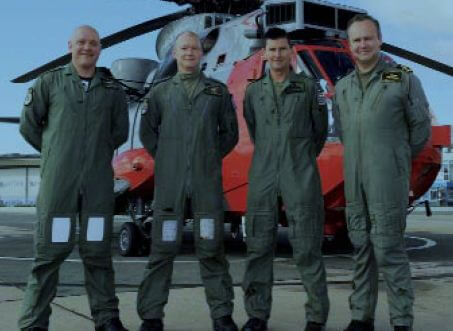
Outstanding professionalism, teamwork, determination and courage saved the lives of four trawlermen.
On the 31 December 2009, late in the afternoon and seven hours into their duty, the crew of “Rescue 193” from RNAS Culdrose was scrambled by the Air Rescue Coordination Centre to assist a casualty with a suspected cardiac arrest at Porthtowan, Cornwall. While on task, Falmouth Coastguard received a mayday call from Fishing Vessel Trevessa that reported a fire onboard with associated loss of steering some 50 nautical miles south west of the Isles of Scilly and that the four-man crew were abandoning ship. “Rescue 193” was tasked to this second incident.
While the mayday call was being received, the Aircraft Commander, Lieutenant Commander Steve Hopkins, calmly focused the crew on completing the current rescue while the Observer, Lieutenant Alex Stevenson, formulated a plan to expedite the rescue of the fishing vessel’s crew. The Winchman, Petty Officer Aircrewman Lacy, was winched down to the first incident to assist the cardiac arrest victim. Despite the developing urgency of the trawler situation, the crew of “Rescue 193” conducted a swift handover to the waiting paramedic crew and, within a couple of minutes, was airborne once more. While the helicopter transited towards the vessel the crew re-organised the medical equipment and got appropriately dressed for a ‘wet’ rescue. Within an hour of the initial call, “Rescue 193” arrived on scene and was immediately faced with an extreme situation; it was dark, with heavy rain, sea state five to six and winds of 35-40 knots; these conspired to create marginal operating conditions for both crew and aircraft. FV Trevessa was a beam trawler with all derricks out, swinging fore and aft. The trawler crew had inflated their life raft, which was attached to the vessel but it was semi-submerged and unusable. The vessel was dead in the water with no power due to fire damage and the crew had evacuated to the last three to four feet of the stern. There was nowhere suitable for a rescue transfer other than the stern as masts, wires and loose fishing gear made all other options far too hazardous. There were no upper deck lights and, once overhead, “Rescue 193” lost all radio communication with the captain of the fishing vessel. Despite the significant risk to their own safety, hovering close to a vessel which posed a very real fire danger and in extremely demanding conditions, the crew of “Rescue 193” elected to conduct a hi-line transfer. Without communications, the crew of the Trevessa were unaware of this plan.
PO Lacy was lowered to the pitching and wallowing deck, but unaware of his intentions, the deck hands made no attempt to assist him as he was being lowered. On the first descent, Lacy managed to hook the heels of his boots over the guardrail, from there he desperately tried to heave himself onto the deck but a heavy swell caused the trawler to pitch down and he fell backwards 20 feet into the icy waters of the Atlantic. Fully submerged but still attached to the winch wire, he was recovered back into the helicopter. Despite his ordeal, PO Lacy immediately elected to go back down for a further attempt to board the vessel and, after crew consultation, the aircraft was positioned for a second attempt. This time a successful hi-line transfer was conducted and, despite the heavy and unpredictable roll of the vessel, PO Lacy co-ordinated and conducted the safe evacuation of all four trawlermen from the stern which took some 50 minutes in the appalling conditions.
Although relatively inexperienced in SAR operations, the flying pilot, Lieutenant Commander Martin Shepherd, remained entirely focused throughout a particularly challenging set of winch transfers and was unperturbed and calm despite the aborted initial attempt when PO Lacy ended up in the water. The calming influence of the Observer, Lieutenant Alex Stevenson, with his accurate conning and consummate professionalism, despite seeing his Winchman disappear into the water, contributed greatly to the success of this dangerous and demanding evolution.
Determined professionalism, high order teamwork and bravery enabled the crew of “Rescue 193” to transition from a complex airborne medical resuscitation, to successfully executing a perilous winch transfer, thereby saving the lives of four men from FV Trevessa in treacherous conditions
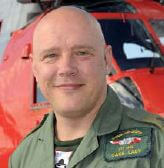
Petty Officer Aircrewman Lacy is awarded a Society’s commendation for his outstanding actions in the recovery of four men from FV Trevessa in dangerous conditions on 31 December 2009.
Outstanding seamanship and teamwork ensured the rescue of two sailors.
On 15 May 2009 Forth Coastguard called the Dunbar Lifeboat Operations Manager at 17:06 requesting
the launch of their all weather lifeboat to provide assistance to yacht Ouhm with two persons onboard in difficulties 37 nautical miles east north east of Dunbar.
A force eight gale was blowing from the east north east; the sea state was very rough with five to seven metres of swell at the launch site. Visibility was at best moderate at approximately two to five nautical miles. The crew consisted of Coxswain Gary Fairbairn; Mechanic, Kenny Peters, Stuart Pirie, Kevin Keillor, Brian Cleator and John Watt.
Before the lifeboat launched Forth Coastguard informed the crew that R/T Magic, a 31 metre 995 ton tug was also proceeding to the assistance of yacht Ouhm. The yacht was reported to have suffered two knockdowns and was experiencing difficulty coping with the extreme weather conditions. There were two persons onboard and under bare poles they were drifting at speeds of up to five knots towards the lee shore on the north side of the Firth of Forth.
At 17:30, Trent class lifeboat, RNLB John Neville Taylor, launched. As the lifeboat cleared the breakwaters at Torness they began to experience seven-metre seas. Speed was restricted to 15 knots for the first hour of steaming. Further offshore the swell became larger and the wind increased to a severe gale force nine. The lifeboat was hit by several breaking seas and these resulted in fendering being torn away, the bow fairlead unlatching and the salvage pump breaking free twice. Once the pump was securely lashed down again the lifeboat continued steaming towards the casualty until she fell about ten metres from the top of a large wave. At this point vibration was felt along the starboard shaft line so Mechanic Peters went below to investigate while Coxswain Fairbairn held the lifeboat head to sea using the port shaft alone. Mechanic Peters reported all was well in the engine room and the lifeboat increased speed. At this point she was hit on her starboard side by a very large, breaking wave. She was laid down onto her beam ends on her port side. The port side wheelhouse windows were underwater and the braces on the whip aerial were bent through the force of the water. The lifeboat swiftly returned to the upright position allowing Coxswain Fairbairn to continue passage towards the casualty.
By 19:45, the lifeboat was in the vicinity of the casualty. Yacht Ouhm was not visible owing to the sea state; however Coxswain Fairbairn and his crew were able to see R/T Magic who was keeping station upwind of Ouhm in an attempt to provide the best lee possible. Eventually the lifeboat located Ouhm, she was only visible when her masthead light shone between the waves, which were by now around ten metres high. Ouhm was lying stern to sea with a drogue of some description deployed.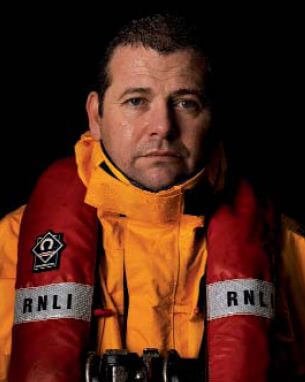
Coxswain Fairbairn made a rapid assessment of the situation and decided that the crew of two required evacuation and the yacht should be abandoned, as a tow would be impossible. After confirming that the yacht was not carrying a life-raft it became apparent that the lifeboat would have to get alongside Ouhm
Once the plan had been decided the lifeboat contacted the skipper of the yacht and informed him of the decision to evacuate him and his wife. The lifeboat crew manned the deck in readiness for an approach to put the lifeboat alongside.
The drogue deployed by the yacht was overwhelmed by the conditions and was no longer able to hold the Ouhm stern to sea. This meant the first approach had to be made while the yacht was laid beam on to the sea. The resulting approach was difficult and the lifeboat was hit by a wave in the late stages, which could have caused a heavy collision that may have damaged the yacht badly or even sunk her. Having checked his crew were still secure and well on deck, Coxswain Fairbairn applied full power astern to maintain separation between the two vessels before bringing the lifeboat around for another approach.
On the second attempt the lifeboat slowly approached the casualty heading into sea. At the last moment Coxswain Fairbairn made a tight turn to port, placing the lifeboat starboard side to alongside the casualty. The crew on deck were able to snatch the female casualty from the deck of the yacht and drag her onboard the lifeboat. At the same time a lifejacket was thrown to the remaining male casualty.
Coxswain Fairbairn used exactly the same technique to make a third approach alongside Ouhm. On this occasion the male was pulled from the deck and over the guardrails of the lifeboat. Both casualties were quickly secured in the wheelhouse and Coxswain Fairbairn having passed his thanks to R/T Magic started their passage back to Torness.
The lifeboat arrived back at Torness at 22:15, a service of just under five hours duration in heavy weather.
Good judgment, courage and determination ensured the rescue of two young men trapped by the tide.
At 12:42 on Wednesday 27 January 2010, the Maritime Rescue Co-ordination Centre at Falmouth contacted the Newquay Lifeboat Operations Manager and requested the launch of the D class Inshore Lifeboat (ILB). Two surfers, who had been surfing at Whipsiderry Bay, three cables north east of Newquay, had become aware of two persons seemingly cut off by the tide and sitting upon rocks close to nearby Fern Cove.
Assuming the worst, the surfers decided to separate, one heading ashore to raise the alarm, while the second, a Mr Craig Sommerville, headed into the cove with his surfboard to assist the two trapped young men, which he did by guiding them across the rocks and around the nearby point to a safer position. The two men, who had been out running and therefore dressed in only shorts and t-shirts, had been trapped for nearly two hours and were by now suffering seriously from the effects of cold.
The lifeboat launched at 12:56 and was on scene at 13:00. The wind was from the north west force four, the weather was overcast and visibility was good. Despite the apparent calm sea conditions, a large north westerly ground swell was present which, combined with a state of tide nearly two hours before high water, made surf conditions in the local area extremely challenging. The surf, averaging two to three metres in height and at intervals of four to five metres, extended approximately three cables to seaward and was breaking violently upon the scattered rocks and boulders which were partially covered and strewn throughout the approaches to Fern Cove. Helmsman Morris, an experienced surfer himself, took time to assess the situation and state of the surf, before committing the ILB and its crew to an initial approach towards the casualties on the rocks. Expertly positioning the ILB on the back of a wave he steered towards the rocks to get a better view of local conditions and to decide whether a recovery by boat was indeed feasible in the prevailing conditions. As the lifeboat closed the shoreline, the number and density of large rocks and boulders that uncovered and then disappeared again with the surf became readily apparent, and the danger to the ILB and her crew quickly became all too clear.
The Coastguard Cliff Rescue Team had also arrived at 13:00 and established themselves on top of the cliffs. Meanwhile, the ILB had closed to within 100 metres of the casualties and was positioned well amongst the hidden rocks and white water, when they were warned by radio from the Coastguard team of an approaching set of larger waves. Rather than risk the incoming seas, Helmsman Morris turned the ILB to face the surf, subsequently punching through a set of 10-12 waves, many of which swamped it before clearing the danger zone.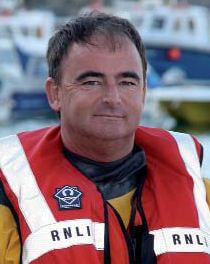
Helmsman Morris carefully judged his timing before turning towards the shore for a second attempt at 13:10. Threading his way through the rocks to an area of relative safety approximately 20 metres to seaward of the casualties, Helmsman Morris assessed the situation. Noting the overhanging nature of the cliffs approximately 70 metres above the rocks, and the treacherous nature of the sea conditions close to the casualties and proximity to navigational hazards, Helmsman Morris dismissed recoveries from above and by boat as far too risky in the conditions and recommended via radio that a helicopter lift would probably be the safest and most appropriate method of recovery.
At this moment things took an unexpected turn as the casualties jumped off the rocks into a nearby gully where they instantly became out of their depth in the high swells. Already very cold and weak from their ordeal and with lacerations to their legs, the two runners were now in severe peril.
Morris took decisive action, manoeuvring the lifeboat to a position close to the mouth of Fern Cove with its bow to seaward and approximately 30 metres from the casualties in the gully. He directed crew members Trebilcock and Martin to disembark the lifeboat. He then disembarked himself, instructing Martin to help him steady the boat while Trebilcock made his way towards the casualties, who were also being washed over and in and out of their depth in the swell. Morris and Martin worked hard at steadying the ILB. The men, both over six feet in height, were one minute waist-deep in water and the next washed off their feet by the two metre swell, stumbling over the large boulders under foot and often fighting to remain upright while keeping hold of the lurching ILB.
Meanwhile, crew member Trebilcock made his way, sometimes swimming, sometimes scrambling across the large boulders in his path, the 30 metres towards the casualties. Making contact with the first casualty, Trebilcock returned with him back across the hidden hazards and surging sea to the lifeboat while Mr Sommerville, the surfer, cared for the other. Both casualties were physically exhausted and showing signs of hypothermia, and Trebilcock literally had to carry and push each one through the surf and over the rocks to the lifeboat. Throughout this time all lifeboat crew and casualties were at risk of being thrown against the rocks by the powerful surge and at severe risk of foot entrapment with potentially very serious consequences. Once the men were on board, Morris and his crew re-boarded the lifeboat, started the engine and headed back out to sea through the surf.
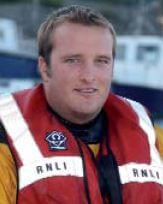
Crew member Aaron Trebilcock is awarded a Society’s commendation for his outstanding role in the rescue of two men from Fern Cove in dangerous conditions on 27 January 2010.
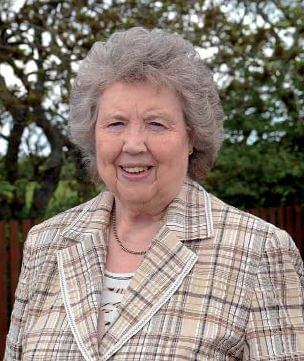
Betty McLean has worked on behalf of the Shipwrecked Mariners’ Society since 1953, firstly as our
contact for 43 years while working for our then Honorary Agents, Richard Irvine and Sons Ltd, a local fishing company in Peterhead, and then after retiring in 1996 when she took over the agency herself.
Betty has dealt with cases requiring immediate relief grants but her efforts have largely been concentrated on fundraising from the corporate sector; primarily the shipping, oil and the fishing industries. Typical of the lady, she is modest about her unprecedented achievements as an Honorary Agent.
“My brother, father, grandfather and great grandfather all worked as fishermen and my nephew still goes fishing now so I have always had a connection to the sea. The Shipwrecked Mariners’ Society worked locally in Peterhead where I lived, so I started collecting subscriptions to support their work and have just kept on going. I love my work; I have worked in the fishing industry all my life and have enjoyed every minute of working with the fisher people.”
Betty’s efforts were first recognised by a Lord Lewin Award in 1996 and in the 14 years since she has continued to work tirelessly on our behalf. Over the years she has raised in the order of £100,000; latterly averaging about £5,000 per year – an impressive achievement by a remarkable lady.
Betty’s unstinting dedication to the Society’s work and the fundraising results she achieves are quite simply without equal and deserving of public recognition.